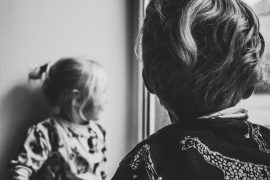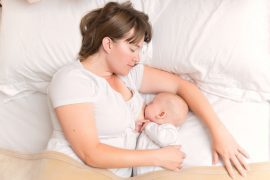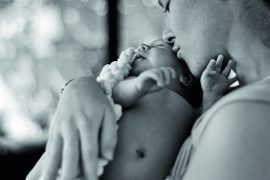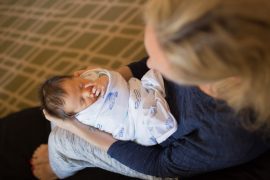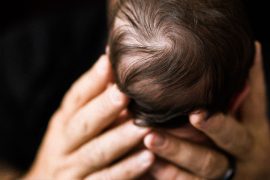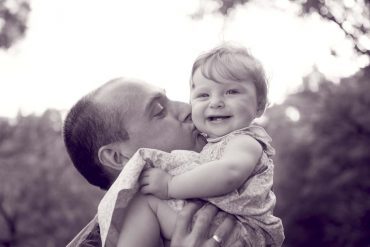By Mary Francell
In today’s technological society, it’s easy to lose sight of the fact that humans are mammals. We give birth to live young and feed our infants milk from our bodies.
More specifically, we are primates, a “carry” species that is biologically programmed to keep our babies close day and night. Humans have slept next to their children on the ground or on mats for millions of years. Bedsharing is biologically normal.
However, modern comforts like soft mattresses and fluffy pillows have introduced hazards to the night-time environment. So how can Western parents safely meet our children’s biological sleep needs?
Read Sweet Sleep
There are some great sleep books out there, but if you can only read one, be sure it’s Sweet Sleep. If you have a partner, read it out loud to each other. You will learn the details of the Safe Sleep Seven for bedsharing (no smoking, stay sober, breastfed baby, no sweat/no swaddle, healthy full-term baby, safe surface, baby on back) and so much more.
If you don’t meet these requirements, you can still cosleep – just be sure to use a commercial cosleeper or “sidecar” a crib to the bed.
And research has shown that by four months old, a healthy baby can share sleep on a safe surface with any responsible non-smoking adult.
Learn to nurse in the “cuddle curl”
During the day, babies love to nap on a reclining parent’s chest. Tummy sleeping is fine in this case and it’s a great time to catch up on reading or binge watching! But at night, mothers around the world instinctively curl around their babies to nurse and sleep.
This “cuddle curl” creates a safe space for baby at the breast with mum’s arm above and legs pulled up below. If this position doesn’t come naturally at first, keep working at it – you may need to move baby down so their head tips back, pull their legs into your tummy or elevate your breast with a small folded towel.
Some parents, even those with small breasts, move their upper leg over onto the bed so they can lean over to nurse with the top breast (stomach sleepers often really like this) or hold baby on their chest while they roll to their other side. Back sleepers sometimes find that a pillow behind them allows them to partly roll onto their backs.
Work on getting comfortable so both you and baby can drift back to sleep while nursing. Firm pillows are ok as long as they are kept away from baby, anchored under your head or between your knees. Dr. James McKenna has found that bedsharing mothers and babies naturally synchronise their sleep patterns, often barely waking together to latch or adjust position before falling back asleep.
Your mattress should be firm – and big
Ditch your waterbed, pillowtop or other soft sleeping surface. If your pillowtop mattress is two sided, turn it over! Or invest in a firm mattress topper – there are quite a few on the market. Futons are a great option for a firm sleeping surface that can be used on the floor or on a low frame.
If you are buying a new mattress, get a king size (or larger!). If you aren’t, consider getting a single mattress and attaching it tightly to your full or queen to make a bigger sleep surface. Pack the crack firmly with a towel if necessary.
Make it safe
For the most part, Western culture views solitary infant sleep as “normal”, so accidents in cribs result in making cribs safer – not getting rid of them. The same should be true for bedsharing – and bedsharing IS biologically normal.
Public health warnings about bedsharing often frighten new parents so much that many end up falling asleep with their babies on far more dangerous surfaces than beds, such as sofas and recliners. Make your bed a safe space and relax knowing that bedsharing while following the Safe Sleep Seven is no more risky than putting baby in a crib nearby.
Tie up dangling cords, strings and even long hair at night. Get rid of extra pillows, stuffed animals and fluffy comforters – use several layers of thin blankets instead and keep them down around your waist. If you are cold, try wearing a soft cardigan sweater and an old shirt with holes cut out for your breasts.
Dockatots and other sleep positioners are not necessary and in fact may pose a suffocation hazard – use them during the day on the floor for naps when an adult is awake in the same room. Babies don’t need silent, dark rooms – in fact, sleeping too deeply is a risk factor for SIDS and ambient noise is thought to be protective.
Check for cracks between the mattress and other parts of the bed – if you find any, pack them tightly with towels or blankets. Do the same if you use a bedrail.
Some parents put a pool noodle at the edge of the bed under the fitted sheet to make a simple guardrail before baby becomes mobile – however, this could also post a suffocation hazard. Pushing your bed against a wall isn’t recommended, as a crack could appear as the mattress shifts.
Put your mattress on the floor
Families around the world sleep on the floor and some doctors even recommend it for back problems. It may take a little getting used to, but this is often the safest option, particularly when baby starts crawling.
If you have solid surface floors, a blanket or quilt underneath that extends out around the sides can cushion the short drop if baby crawls off. With carpet, be sure to vacuum around the mattress regularly to remove dust.
Lift up the mattress every week or so to air it out and prevent mold. Be sure to childproof the rest of the room.
Don’t worry – it won’t be long before you can have an elevated bed again. Older toddlers can be taught to get down feet first. When my children were young, we took apart our bedframe and stored it in another room with the box spring for a few years. They are now in their early twenties and I have a hard time remembering what it was like to sleep on the floor!
Try to relax
This is probably the hardest part for modern parents. The internet is full of conflicting information and dire warnings about bedsharing. Remember that our species is biologically programmed to sleep with our babies – if it were inherently dangerous, we wouldn’t be here today.
Follow the Safe Sleep Seven, make your bed a safe space and enjoy cuddling with your baby. In my interview with Dr. James McKenna on the Attachment Parenting podcast, he says, “…one of the greatest joys you can have (is) knowing you are protecting and nurturing your baby in a most healthy way, which is to sleep next to it and, if mothers can, to breastfeed through the night.”


